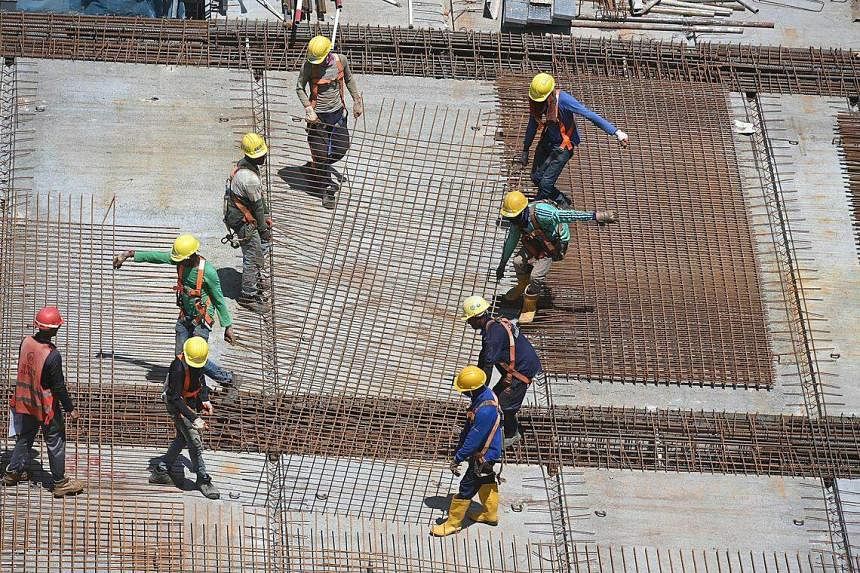SINGAPORE – Companies will have to deploy video surveillance systems at construction sites for projects valued at $5 million or more from June 2024, in a bid to improve worker safety.
The new requirement was part of a suite of measures announced on Tuesday to reduce workplace deaths and injuries – especially in high-risk sectors – as the Ministry of Manpower (MOM) said the ongoing heightened safety period will end on May 31, 2023, after a three-month extension in February.
Video systems will be required at construction sites where high-risk activities take place, and companies will bear the cost of implementing them, the authorities said. Further details on the roll-out will be announced when ready.
The systems will be used to deter unsafe behaviour, identify workplace safety and health risks, and facilitate investigations into incidents. In the past two years, companies that committed serious safety offences have been required to implement such systems, and MOM said feedback garnered thus far has been positive, with firms able to better monitor on-site working conditions.
The ministry said the $5 million threshold was fixed based on past cases, as the majority of previous fatal and major injury incidents occurred at projects costing this amount or more.
Other measures to be rolled out include tightening safety requirements for government construction projects in future, and requiring the chief executives and board directors of all companies in higher-risk industries to attend a half-day programme on safety from March 2024.
These initiatives come amid a rise in the rate of major injuries. The major injury rate per 100,000 workers rose to 19.2 for the period from September 2022 to March 2023, up from 16.8 for the January-to-August period in 2022.
This increase occurred in spite of the heightened safety period that MOM imposed from Sept 1, 2022, following a rise in workplace deaths between January and August that year, when 36 deaths were recorded – one fewer than the 37 for the whole of 2021. There were 46 deaths in all in 2022, and 11 so far this year.
Speaking at the launch of the National Workplace Safety and Health Campaign on Tuesday at Singapore Expo, Senior Minister of State for Manpower Zaqy Mohamad said the heightened safety period “has served its purpose as an urgent call on employers to prioritise safety and has brought down workplace fatalities”.
The fatality rate per 100,000 workers fell from 1.5 for the period from January to August 2022, to 0.8 for the period from September 2022 until now. This means the average number of deaths fell by almost half, from 4.5 per month before the measure to 2.3 while it is in force, Mr Zaqy noted.
He also said the measure cannot be extended indefinitely. “It relies primarily on tougher enforcements and penalties, and is not a sustainable approach.”
MOM said that from the start of the heightened safety period till end-April, it issued 70 stop-work orders and close to 1,300 composition fines amounting to more than $2.6 million for offences such as unsafe scaffolds. As at May 8, 25 companies were also banned from hiring new foreign workers for up to three months under heightened safety period rules.
As the period ends, said Mr Zaqy, “we need to recognise that it takes the collective will, responsibility and effort of the entire ecosystem to keep our workers safe and healthy”.
Some measures that were implemented during the period, such as requiring chief executives to personally account to the authorities for serious safety lapses, will be retained, MOM said. A multi-agency workplace safety task force – set up in October 2022 – will also be kept to look at how to further improve safety.
Most of the new measures announced on Tuesday will be rolled out over the next six months to a year, to give firms time to adjust.
One initiative still in the works is the tightening of safety requirements in government tenders for public construction and construction-related projects.
For now, requirements that are being considered include disqualifying contractors with a poor safety record from participating in tenders, introducing a minimum safety weightage for tender evaluation, and giving bonus points during evaluation to firms with good safety performance.
Senior Minister of State for National Development Tan Kiat How said the Government – as a major developer – will lead by example by placing greater emphasis on safety considerations for its tenders. For instance, firms with good safety track records could be considered more favourably, he said. He will consult the industry before the Government finalises the criteria and gives more details.
The authorities will also address sector-specific trends, such as an increase in the death and major injury rate in the manufacturing sector in recent months.
A demerit point system that is currently in place for the construction sector will be extended to the manufacturing sector from October. Under the system, companies that accumulate sufficient demerit points for safety lapses will be barred from hiring new foreign employees for between three months and two years.
Singapore Manufacturing Federation president Lennon Tan said the rise in deaths and major injuries could be down to inexperience, especially as many experienced workers returned home when borders reopened. Accidents could also be caused by lapses when firms rush to fulfil orders, he said, urging supervisors to pay closer attention to safety at their workplaces. He hopes the new measures will be implemented with a light touch at the start, so that companies can adapt.


